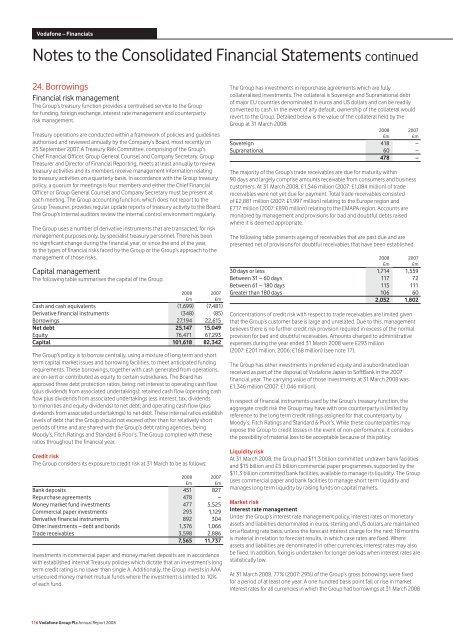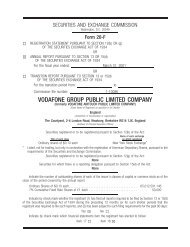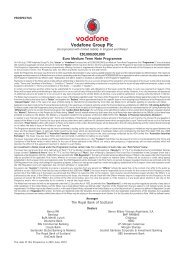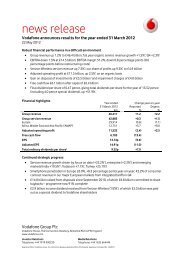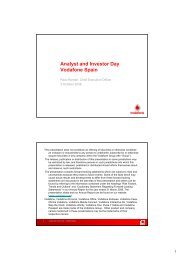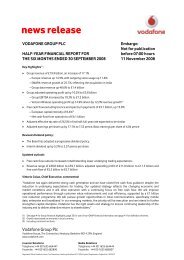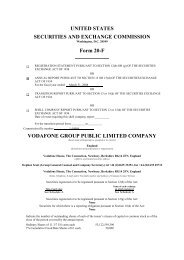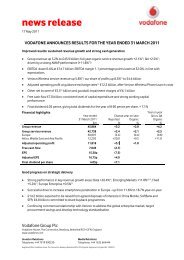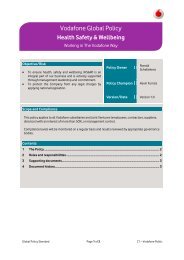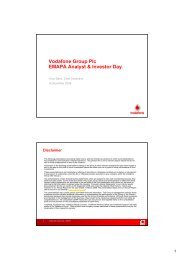Create successful ePaper yourself
Turn your PDF publications into a flip-book with our unique Google optimized e-Paper software.
<strong>Vodafone</strong> – Financials<br />
Notes to <strong>the</strong> Consolidated Financial Statements continued<br />
24. Borrowings<br />
Financial risk management<br />
The Group’s treasury function provides a centralised service to <strong>the</strong> Group<br />
for funding, foreign exchange, interest rate management and counterparty<br />
risk management.<br />
Treasury operations are conducted within a framework of policies and guidelines<br />
authorised and reviewed annually by <strong>the</strong> Company’s Board, most recently on<br />
25 September 2007. A Treasury Risk Committee, comprising of <strong>the</strong> Group’s<br />
Chief Financial Officer, Group General Counsel and Company Secretary, Group<br />
Treasurer and Director of Financial Reporting, meets at least annually to review<br />
treasury activities and its members receive management information relating<br />
to treasury activities on a quarterly basis. In accordance with <strong>the</strong> Group treasury<br />
policy, a quorum for meetings is four members and ei<strong>the</strong>r <strong>the</strong> Chief Financial<br />
Officer or Group General Counsel and Company Secretary must be present at<br />
each meeting. The Group accounting function, which does not <strong>report</strong> to <strong>the</strong><br />
Group Treasurer, provides regular update <strong>report</strong>s of treasury activity to <strong>the</strong> Board.<br />
The Group’s internal auditors review <strong>the</strong> internal control environment regularly.<br />
The Group uses a number of derivative instruments that are transacted, for risk<br />
management purposes only, by specialist treasury personnel. There has been<br />
no significant change during <strong>the</strong> financial year, or since <strong>the</strong> end of <strong>the</strong> year,<br />
to <strong>the</strong> types of financial risks faced by <strong>the</strong> Group or <strong>the</strong> Group’s approach to <strong>the</strong><br />
management of those risks.<br />
Capital management<br />
The following table summarises <strong>the</strong> capital of <strong>the</strong> Group:<br />
2008 2007<br />
£m £m<br />
Cash and cash equivalents (1,699) (7,481)<br />
Derivative financial instruments (348) (85)<br />
Borrowings 27,194 22,615<br />
Net debt 25,147 15,049<br />
Equity 76,471 67,293<br />
Capital 101,618 82,342<br />
The Group’s policy is to borrow centrally, using a mixture of long term and short<br />
term capital market issues and borrowing facilities, to meet anticipated funding<br />
requirements. These borrowings, toge<strong>the</strong>r with cash generated from operations,<br />
are on-lent or contributed as equity to certain subsidiaries. The Board has<br />
approved three debt protection ratios, being: net interest to operating cash flow<br />
(plus dividends from associated undertakings); retained cash flow (operating cash<br />
flow plus dividends from associated undertakings less interest, tax, dividends<br />
to minorities and equity dividends) to net debt; and operating cash flow (plus<br />
dividends from associated undertakings) to net debt. These internal ratios establish<br />
levels of debt that <strong>the</strong> Group should not exceed o<strong>the</strong>r than for relatively short<br />
periods of time and are shared with <strong>the</strong> Group’s debt rating agencies, being<br />
Moody’s, Fitch Ratings and Standard & Poor’s. The Group complied with <strong>the</strong>se<br />
ratios throughout <strong>the</strong> financial year.<br />
Credit risk<br />
The Group considers its exposure to credit risk at 31 March to be as follows:<br />
2008 2007<br />
£m £m<br />
Bank deposits 451 827<br />
Repurchase agreements 478 –<br />
Money market fund investments 477 5,525<br />
Commercial paper investments 293 1,129<br />
Derivative financial instruments 892 304<br />
O<strong>the</strong>r investments – debt and bonds 1,376 1,066<br />
Trade receivables 3,598 2,886<br />
7,565 11,737<br />
Investments in commercial paper and money market deposits are in accordance<br />
with established internal Treasury policies which dictate that an investment’s long<br />
term credit rating is no lower than single A. Additionally, <strong>the</strong> Group invests in AAA<br />
unsecured money market mutual funds where <strong>the</strong> investment is limited to 10%<br />
of each fund.<br />
116 <strong>Vodafone</strong> Group Plc Annual Report 2008<br />
The Group has investments in repurchase agreements which are fully<br />
collateralised investments. The collateral is Sovereign and Supranational debt<br />
of major EU countries denominated in euros and US dollars and can be readily<br />
converted to cash. In <strong>the</strong> event of any default, ownership of <strong>the</strong> collateral would<br />
revert to <strong>the</strong> Group. Detailed below is <strong>the</strong> value of <strong>the</strong> collateral held by <strong>the</strong><br />
Group at 31 March 2008:<br />
2008 2007<br />
£m £m<br />
Sovereign 418 –<br />
Supranational 60 –<br />
478 –<br />
The majority of <strong>the</strong> Group’s trade receivables are due for maturity within<br />
90 days and largely comprise amounts receivable from consumers and business<br />
customers. At 31 March 2008, £1,546 million (2007: £1,084 million) of trade<br />
receivables were not yet due for payment. Total trade receivables consisted<br />
of £2,881 million (2007: £1,997 million) relating to <strong>the</strong> Europe region and<br />
£717 million (2007: £890 million) relating to <strong>the</strong> EMAPA region. Accounts are<br />
monitored by management and provisions for bad and doubtful debts raised<br />
where it is deemed appropriate.<br />
The following table presents ageing of receivables that are past due and are<br />
presented net of provisions for doubtful receivables that have been established.<br />
2008 2007<br />
£m £m<br />
30 days or less 1,714 1,559<br />
Between 31 – 60 days 117 72<br />
Between 61 – 180 days 115 111<br />
Greater than 180 days 106 60<br />
2,052 1,802<br />
Concentrations of credit risk with respect to trade receivables are limited given<br />
that <strong>the</strong> Group’s customer base is large and unrelated. Due to this, management<br />
believes <strong>the</strong>re is no fur<strong>the</strong>r credit risk provision required in excess of <strong>the</strong> normal<br />
provision for bad and doubtful receivables. Amounts charged to administrative<br />
expenses during <strong>the</strong> year ended 31 March 2008 were £293 million<br />
(2007: £201 million, 2006: £168 million) (see note 17).<br />
The Group has o<strong>the</strong>r investments in preferred equity and a subordinated loan<br />
received as part of <strong>the</strong> disposal of <strong>Vodafone</strong> Japan to SoftBank in <strong>the</strong> 2007<br />
financial year. The carrying value of those investments at 31 March 2008 was<br />
£1,346 million (2007: £1,046 million).<br />
In respect of financial instruments used by <strong>the</strong> Group’s treasury function, <strong>the</strong><br />
aggregate credit risk <strong>the</strong> Group may have with one counterparty is limited by<br />
reference to <strong>the</strong> long term credit ratings assigned for that counterparty by<br />
Moody’s, Fitch Ratings and Standard & Poor’s. While <strong>the</strong>se counterparties may<br />
expose <strong>the</strong> Group to credit losses in <strong>the</strong> event of non-performance, it considers<br />
<strong>the</strong> possibility of material loss to be acceptable because of this policy.<br />
Liquidity risk<br />
At 31 March 2008, <strong>the</strong> Group had $11.3 billion committed undrawn bank facilities<br />
and $15 billion and £5 billion commercial paper programmes, supported by <strong>the</strong><br />
$11.3 billion committed bank facilities, available to manage its liquidity. The Group<br />
uses commercial paper and bank facilities to manage short term liquidity and<br />
manages long term liquidity by raising funds on capital markets.<br />
Market risk<br />
Interest rate management<br />
Under <strong>the</strong> Group’s interest rate management policy, interest rates on monetary<br />
assets and liabilities denominated in euros, sterling and US dollars are maintained<br />
on a floating rate basis, unless <strong>the</strong> forecast interest charge for <strong>the</strong> next 18 months<br />
is material in relation to forecast results, in which case rates are fixed. Where<br />
assets and liabilities are denominated in o<strong>the</strong>r currencies, interest rates may also<br />
be fixed. In addition, fixing is undertaken for longer periods when interest rates are<br />
statistically low.<br />
At 31 March 2008, 77% (2007: 29%) of <strong>the</strong> Group’s gross borrowings were fixed<br />
for a period of at least one year. A one hundred basis point fall or rise in market<br />
interest rates for all currencies in which <strong>the</strong> Group had borrowings at 31 March 2008


